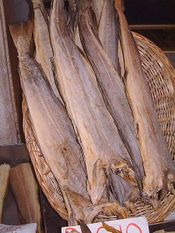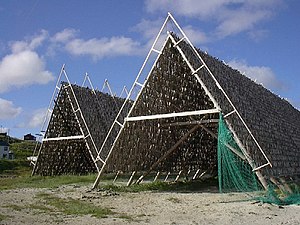Baccalà alla Vicentina
Stockfish is unsalted fish dried naturally by sun and wind on wooden racks called hjell, or in special drying houses. The drying of food is the worlds oldest known preservation method, and dried fish has a storage life of several years. The method is also cheap, the work can be done by the fisherman, and the resulting product is easily transported to its market.
Cod is the most common fish used in stockfish production, while other white meat fish, such as pollock, haddock, ling and cusk is used to a lesser degree. During the centuries several variants of stockfish evolved, including the salted clipfish. Salting was not economically feasible before the 17th century, when cheap salt from southern Europe became available. Both stockfish and clipfish can be processed to lutefisk.
Beside oil, gas, and income from the merchant fleet, stockfish is Norways longest sustained export commodity, and the socioeconomically most profitable export during the centuries.
Manufacturing and usage
The science of producing good stockfish is in many ways comparable to that of making a good cognac, parma ham, or a well matured cheese.
The fish is prepared immideately after capture. After gutting the fish, it is either dried whole, or split along the spine leaving the tail connected.
The fish is hung on the hjell from Feburary to May. The cold climate protects the fish from insects and prevents bacterial growth. A temperature just above zero degrees celsius, with little rain, is ideal. Too much frost will spoil the fish, as ice destroyes the fibers in the fish. The climate in northern Norway is excellent for stockfish production. Due to the stable conditions, the stockfish produced in Lofoten is regarded as the best. The traditional cod harvest in Lofoten also takes place during the best drying time.

The fish hangs on the hjell approximately three months. The fish is then matured for 2-3 months indoors in a dry and airy environment. During the drying, about 70% of the water in the fish disappears. The stockfish retains all the nutrients from the fresh fish, only concentrated: it is therefore rich in proteins, vitamins, iron, and calcium.
After sorting by quality, most of the stockfish is exported to Italy and Croatia. In Norway, the stockfish is mostly used as a snack and for lutefisk production. Low-quality stockfish is also commonly used as supplemental food for pets, primarily as dog food or dog treats. In Italy, the fish (called stoccafisso) is soaked and used in various courses, and is viewed as a delicacy.
Dishes
The baccalà alla vicentina, an ancient and traditional italian dish native to Vicenza, is made from stockfish (not from from salted cod, or baccalà, despite the name) and is served on or next to polenta.
